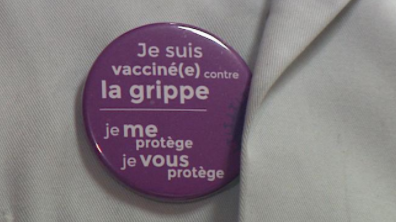The last few weeks have been marked by some of the first good news of 2020 – the dawn of several COVID-19 vaccines upon their approval from multiple global healthcare regulatory agencies. The news has been accompanied by the launch of concurrent campaigns from governments and health organisations to improve uptake of these next-generation vaccines.
France, like many other countries around the world, is now preparing to embark on one of the largest vaccination rollouts of its history – with uptake campaigns expected to launch in the new year.
The French Haute Autorité de Santé has suggested a five-phase rollout of the vaccines, with the first phase focusing on the vaccination of care home residents and staff. This choice, which partly reflects the prioritisation choices made each year for influenza vaccinations, is explained by the need to vaccinate the people most likely to be severely affected by the virus. It assumes, however, that this group of people will agree to be vaccinated. Yet, recent polls from Ipsos suggest that over half of French people do not intend to get vaccinated against COVID-19. Indeed, only a third (32%) of health workers in care homes were vaccinated against the regular flu in 2019 according to Santé publique France.
As part of a mission with the Direction Interministérielle de la Transformation Publique, we are currently working with Santé publique France and the French Ministry of Health on a project to identify and address some of the barriers to influenza vaccination in care homes. We are piloting solutions in the south of France as we speak, but believe several lessons we have learnt along the way are worth sharing now, as they can help inform campaigns promoting COVID-19 vaccine uptake. Here’s what we’ve learned:
1. Include all professionals in the vaccination campaign
We understand that in the plan as it currently stands for care homes, only residents and vulnerable staff members will receive priority access to the COVID-19 vaccination. However, it seems important to extend this prioritisation to all care home personnel, whatever their profession (nursing, administrative, technical) and to consider the risks of all workers contracting serious forms of COVID-19. To include all professionals is simpler to organise, but also recognises the colossal teamwork that has been done by the entire care home staff since the beginning of this pandemic.
2. Too much information can undermine core messages
Our research has shown that many uncertainties persist, even among caregivers, about the efficacy and safety of influenza vaccines – and we already know that the same will be true for COVID-19 vaccines. Providing clear information, based on scientific evidence, is therefore a prerequisite to rollout.
However, through our working with care home directors, it became clear that staff already receive a great deal of information from multiple sources including: messages from social security agencies, regional health authorities, professional federations, the Ministry of Health – not to mention what they see in the media. Given the importance of vaccinations, it is natural to see such mobilisation around their deployment. However, faced with mountains of information, care home directors and their teams sometimes don’t know where to start, and are at the risk of ignoring certain information completely or of focusing only on things that confirm what they already believe.
Therefore, a real effort of coordination is needed to create simple and coherent communications for the COVID-19 vaccine campaign.
Behavioural science can then offer solutions to make the communications easy, attractive, social, and timely. But before launching communications it is important not only to test which messages are likely to be the most convincing, but also to ask ourselves some important questions like: Who do French people trust the most?; Which actors are people more likely to listen to?; And which information platform do people prefer to receive these messages on?
3. Above all, access to vaccination must be as simple as possible
Beyond information campaigns, experts agree on one point: access to the COVID-19 vaccine must be simplified as much as possible. Indeed, even when individuals recognise the need to be vaccinated and do not reject it in theory, many people do not ultimately get vaccinated. This may be because they lack time and energy, or because the obstacles to overcome inertia require too much effort.
To bridge this gap between intention and action, the key is to make vaccination as effortless and inexpensive as possible. For staff working in care homes this could be done by providing free vaccinations at their place of work, during working hours, or at a time pre-arranged by facility managers.
This type of upfront planning has another big advantage. Namely by controlling the day and time at which one gets vaccinated, it becomes easier to manage stocks and to avoid the disappointments associated with depleted stocks (which we have seen all too often with influenza vaccination, and which may further reduce the likelihood that someone will get vaccinated).
4. Additional behavioural levers can further encourage uptake
At BIT, we have been working for several years on the barriers to vaccination. Our work, along with that of other behavioural science researchers, has made it possible to identify levers to boost the uptake of vaccines. In particular, it has been suggested to make vaccinations more salient by: giving a badge to those who have been vaccinated; encouraging them to share their vaccine experience on social media; and making getting a vaccine the default option. This heightened salience could boost vaccine uptake through adherence to perceived social norms.

Source : https://www.francetvinfo.fr/
Our work in care homes of Nouvelle-Aquitaine also highlighted the potential of the behavioural concept of reciprocity (i.e. our tendency to respond to positive behaviours with other positive behaviours), which has been shown to encourage the adoption of desired behaviours, such as charity donations. Messages written by residents to thank staff in advance for getting vaccinated against COVID-19 could therefore be effective in boosting uptake. Care home directors with whom we have interacted appreciated this idea, which they felt would help foster trust between residents and staff.
What next?
These lessons obviously extend beyond care homes. Behavioural science has a crucial role to play in supporting this final stretch in the fight against the pandemic, whether it is by supporting the planning of vaccination campaigns, or by creating messages and incentives to encourage vaccination. Through our online testing platform, Predictiv, for example, we have already started testing several messages encouraging individuals to get vaccinated in the United States.
If you would like to know more, or would like to collaborate with us in this latest step against COVID-19, please contact us at BIT.





